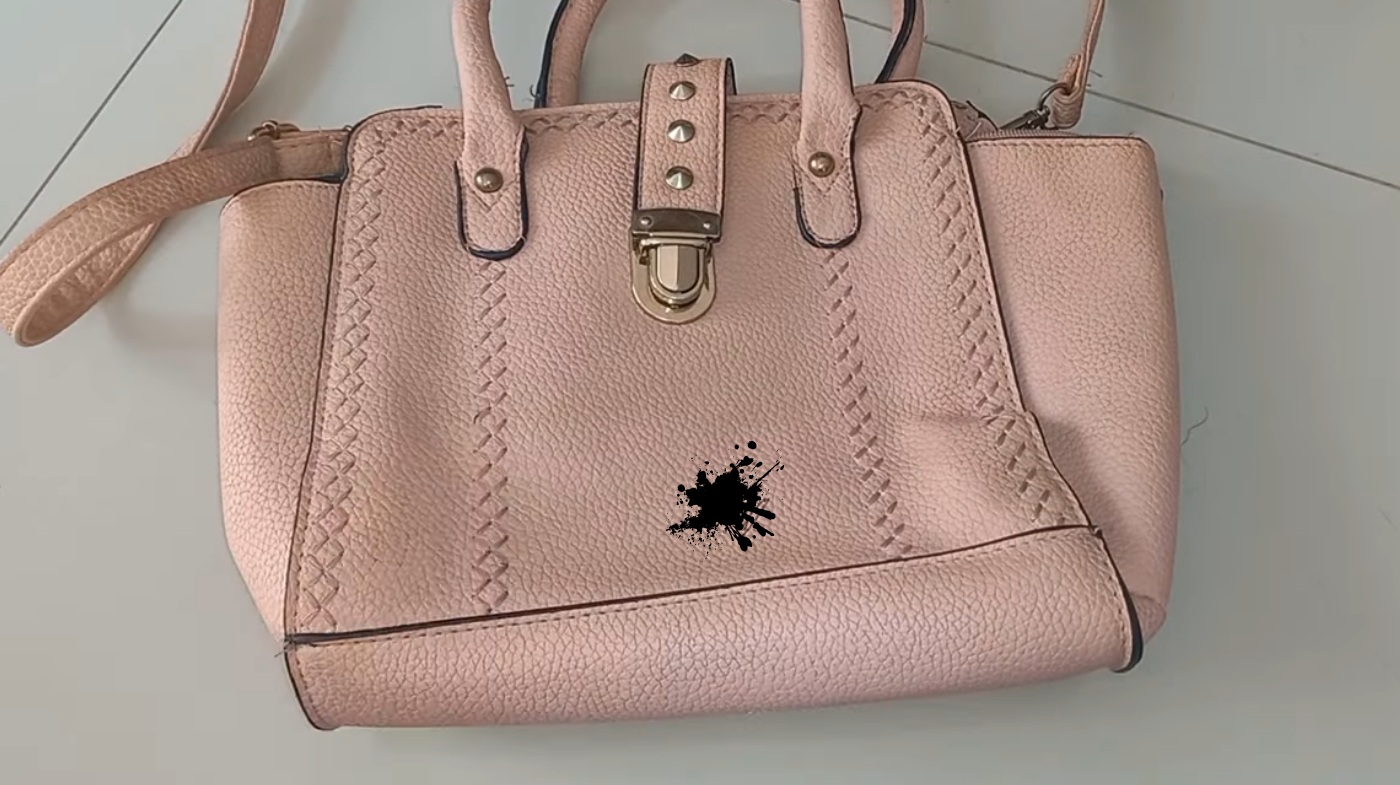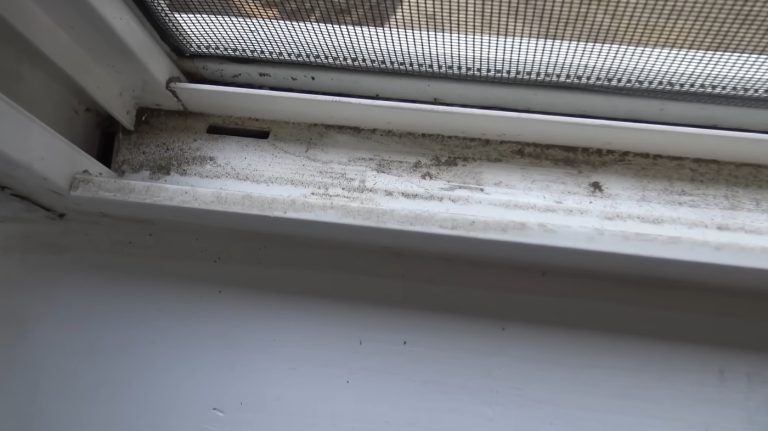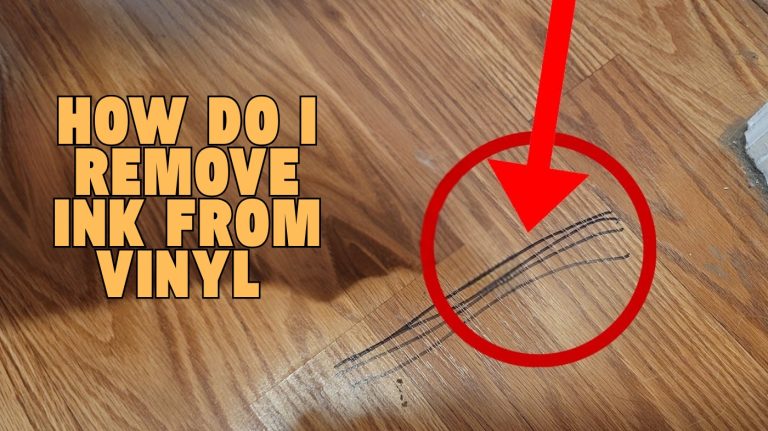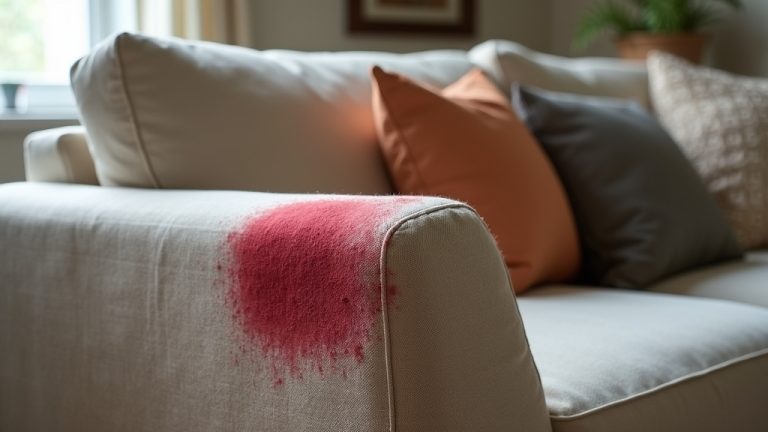How to Remove Ink Stains From Leather Handbags? Easy Steps
If you get ink on your leather handbag, act immediately by blotting gently with a dry cloth to avoid spreading.
Use a mild soap and water solution or carefully dab diluted isopropyl alcohol on the stain, always testing a hidden spot first.
Avoid harsh chemicals to protect the leather’s finish. After cleaning, let it dry fully and apply a leather conditioner to restore moisture and softness. Discover precise techniques and maintenance tips to keep your handbag pristine.
Key Takeaways
- Blot fresh ink stains gently with a dry cloth immediately to prevent spreading and deep penetration into the leather.
- Dab diluted isopropyl alcohol or white vinegar on ink spots cautiously, testing on a hidden area first to avoid discoloration.
- Clean with mild soap and warm water using a soft cloth in circular motions, then air dry away from heat or sunlight.
- Apply a pH-balanced leather conditioner after cleaning to restore moisture and prevent dryness or cracking.
- Store handbags in dust bags, avoid direct sunlight, and use protective sprays to maintain leather quality and prevent future stains.
Quick Actions to Take When You Notice an Ink Stain
When you spot an ink stain on your leather handbag, start by gently blotting it with a clean, dry cloth or paper towel to lift fresh ink without spreading it.
Avoid rubbing, as this pushes ink deeper or broadens the stain. Blot from the stain’s outer edges inward to contain it effectively.
Change to a fresh cloth section frequently to prevent reapplying ink. Acting promptly is crucial because fresh ink penetrates leather rapidly, increasing the risk of permanent damage.
Next, identify your leather type—real, suede, patent, or specialty—as each demands specific care.
Conduct a discreet patch test before any treatment to ensure no damage occurs. Keep manufacturer instructions in mind to avoid voiding warranties or causing harm.
Using gentle, non-abrasive cleaning methods similar to those recommended for safe solvent choices on delicate surfaces helps preserve the leather’s finish and integrity.
Using Soap and Water to Gently Clean Ink From Leather
After taking immediate measures to blot fresh ink stains, the next step involves using a mild soap and water solution to gently lift remaining ink from your leather handbag.
Mix a drop of mild soap, such as dish or castile soap, with a cup of warm water. Dampen a clean, soft white cloth—wring it thoroughly to avoid excess moisture.
Gently blot the stain, working from edges toward the center to prevent spreading. Use light, circular motions without rubbing vigorously.
Proper identification of the stain size helps ensure you apply the right amount of solution without causing damage. It is important to avoid excessive moisture as it can cause damage similar to the overheating risks discussed in oven maintenance.
Replace or clean the cloth as it picks up ink. Once the ink lifts, wipe the area with a clean, slightly damp cloth to remove soap residue. Air dry naturally, away from heat or sunlight.
Applying Alcohol-Based Solutions Safely on Leather
When applying alcohol-based solutions, always use a lightly dampened cloth to gently blot the ink stain. Avoid heavy saturation that can damage the leather.
It is important to test on small areas first to ensure the solution does not cause discoloration or dryness.
After treatment, condition the leather promptly with a quality product to restore moisture and flexibility. This methodical approach minimizes harm and preserves your handbag’s appearance.
Additionally, understanding the chemical compatibility of cleaning agents with leather can prevent unintended damage during stain removal.
Proper Alcohol Application
Although alcohol-based solutions can effectively remove ink stains from leather, applying them requires careful preparation and technique to prevent damage.
Use isopropyl alcohol diluted with water to minimize harsh effects, and never apply pure rubbing alcohol directly.
Before full treatment, test the solution on a hidden spot to check for discoloration. Clean the leather gently beforehand to avoid embedding dirt. It is also important to condition the leather after cleaning to restore moisture and protect the surface.
Some cleaning products contain ammonium hydroxide which can help stabilize solutions but may be too harsh for leather.
Apply the alcohol sparingly with a soft cloth using a gentle blotting motion only on the stained area—avoid saturating the leather.
After blotting, let the leather air dry naturally, away from heat or sunlight. Rubbing alcohol typically dries within minutes, which helps minimize potential damage.
Always avoid repeated use to prevent drying. Remove any residue with a damp cloth afterward, and monitor the leather for any adverse reactions over the next 48 hours.
Post-Treatment Conditioning
If you’ve used alcohol-based solutions to remove ink stains from your leather handbag, conditioning the leather immediately afterward is critical to maintain its integrity. Alcohol strips natural oils, drying the leather and risking cracking or discoloration.
First, let the leather air dry completely. Using a cloth wetted with an Alcohol Cleaner can help remove residual oils and grime before conditioning. It is important to ensure proper ventilation during this process to minimize exposure to fumes.
Then, apply a pH-balanced, leather-specific conditioner rich in natural oils and waxes—avoid household oils. Use a soft cloth to spread thin, even layers, preventing saturation.
After conditioning, gently buff the surface to restore softness and sheen. Test any product on a hidden area before full use.
Natural Abrasive Methods for Tough Ink Stains
Because tough ink stains resist simple cleaning, you’ll need natural abrasive methods to restore your leather handbag effectively.
These methods use gentle, natural ingredients combined with controlled abrasion to lift stains without damaging the leather.
- Baking Soda Mild Abrasion: Slightly moisten baking soda, then rub gently in circular motions on the stain. Wipe with a damp cloth and condition afterward to avoid dryness. Applying leather conditioner after cleaning helps restore suppleness and protects the leather. Regular maintenance with natural cleaning solutions can also prevent buildup and keep the material looking fresh.
- Lemon Juice and Cream of Tartar Paste: Mix equal parts lemon juice and cream of tartar into a paste. Apply briefly, avoid over-wetting, then wipe off once ink lifts.
- Vinegar and Cornstarch Paste: Create a thick paste from white vinegar and cornstarch. Let sit for several hours before gently removing. Clean and condition leather to restore moisture.
Household Remedies to Try for Ink Removal
Natural abrasive methods can handle stubborn ink stains, but sometimes you need simpler solutions using items already in your home.
Start with a mild soap and warm water mixture, applying it gently with a soft cloth from the edges inward to avoid spreading the ink.
Because leather is porous and stain-prone, acting quickly helps prevent ink from setting deeply into the material. Like granite, leather’s porosity affects stain absorption, so initial treatment speed is key.
For tougher stains, use isopropyl rubbing alcohol applied carefully with a cotton swab—dab, don’t rub—to lift ink without oversaturating the leather.
You can try diluted white vinegar and water, but only briefly, followed by soap and water cleaning to prevent damage.
Avoid nail polish remover and harsh solvents, as they risk discoloration and leather damage. Hairspray, though alcohol-based, should be used cautiously due to drying effects. Always test any solution on a small, hidden area first.
Essential Aftercare to Maintain Your Leather Handbag
While cleaning ink stains is important, maintaining your leather handbag regularly guarantees its longevity and appearance.
After stain removal, immediate cleaning with a mild leather cleaner and conditioning is essential to restore oils and prevent stiffness.
This process helps avoid drying or warping caused by exposure to excessive heat or sunlight.
Additionally, protecting your handbag from moisture and dirt by applying a protective sealant can significantly enhance its durability. Follow-up care ensures your bag stays supple and visually appealing.
To maintain your leather handbag effectively:
- Clean your handbag routinely with a soft cloth and perform deep cleaning yearly using leather-specific products.
- Condition the leather using appropriate products, massaging gently and allowing absorption to prevent cracking.
- Store the handbag in a cool, dry place inside a breathable dust bag, keeping it stuffed to preserve shape and applying protective sprays for moisture resistance.
Frequently Asked Questions
Can Ink Stains on Leather Handbag Be Removed Without Risking Color Fading?
Yes, you can remove ink stains from your leather handbag without risking color fading if you act carefully. Start by gently blotting the stain with a cloth dampened in rubbing alcohol or white vinegar—never rub aggressively.
Always test any cleaning agent on a hidden spot first. After cleaning, apply a leather conditioner to restore moisture and protect the color.
Avoid harsh chemicals, prolonged solvent exposure, and harsh scrubbing to preserve your bag’s vibrancy.
How Long Should I Wait Before Applying Any Ink Removal Treatment?
Think of ink on leather like a shadow at sunset—it darkens quickly and becomes harder to erase. You shouldn’t wait long before treating it; act immediately after blotting excess ink gently.
Some treatments need a few minutes to penetrate, but don’t delay too much or the stain sets deeply. Quick, careful action prevents damage and color fading, preserving the leather’s integrity while maximizing stain removal success.
Are Ink Stain Removers Safe for All Types of Leather Finishes?
Ink stain removers aren’t safe for all leather finishes. You need to identify your leather type first.
For coated leathers like patent or top-coated, specialized removers work well and cause minimal damage. But for uncoated or delicate leathers such as aniline, suede, or vegetable-tanned, these chemicals can cause discoloration, drying, or texture changes.
Always perform a patch test and consider professional cleaning for sensitive materials to avoid ruining your leather.
What Should I Avoid Doing Immediately After an Ink Stain Occurs?
You might think scrubbing the ink stain immediately will make it vanish, but that only spreads it further and pushes ink deeper into the leather. Don’t grab harsh chemicals or soak your item with water—that risks discoloration and damage.
Avoid aggressive rubbing, heat drying, and rough fabrics, too. Instead, gently blot excess ink and wait. Patience and careful handling protect the leather’s finish and prevent worsening the stain.
How Often Can I Condition My Leather Handbag After Cleaning?
You should wait at least 24 to 48 hours after cleaning before conditioning your leather handbag to make certain it’s completely dry.
Then, condition it about twice a year under normal conditions. If you’re in hot, dry climates or expose your bag to sunlight often, increase conditioning to every 2-3 months.
Avoid over-conditioning; too frequent applications can leave residues and damage leather texture. Always apply conditioner sparingly with a soft cloth for best results.
Keep Your Leather Handbag Spotless with Smart Care
Removing ink stains from leather handbags requires prompt and careful action to preserve their quality. Did you know that 85% of leather damage occurs due to improper cleaning methods?
By following immediate steps, using gentle soap and water, and cautiously applying alcohol-based solutions or natural abrasives, you can effectively tackle stains without harming your bag.
Always finish with proper aftercare to maintain its look and longevity—your leather deserves nothing less.







